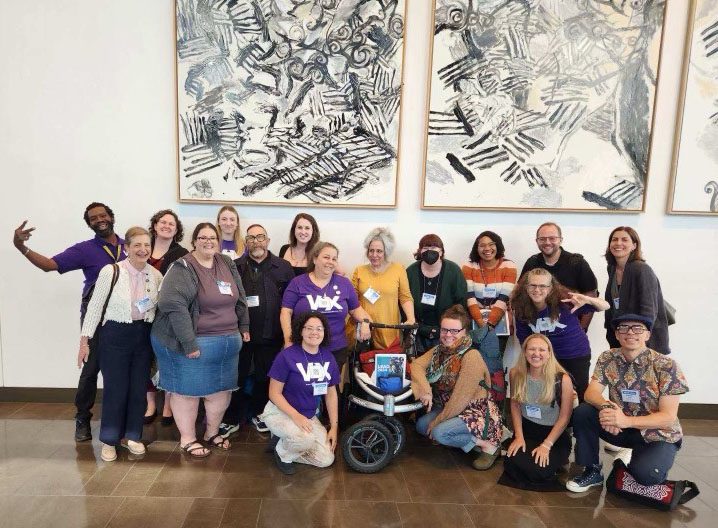Power of Culture Blog
Card to Culture Shout Out – Sept
We are grateful to these 50 cultural organizations committed to a more accessible cultural sector
Dawn Heinen, Digital Communications Manager

Earlier this month, a handful of Mass Cultural Council staff attended the Leadership Exchange in Arts and Disability (LEAD®) conference in Seattle. This conference, renowned as the premier learning opportunity for promoting the full inclusion of people with disabilities in arts and culture, provided valuable professional development that strengthens our internal capacity to advance the d/Deaf & Disability Equity Plan. Here is some of what they brought away from the experience:
Michael J. Bobbitt, Executive Director: The highlight for me is seeing accessibility practices happening in all aspects, where people with disabilities are all fully engaged, seemingly comfortable, and in rooms filled with love and joy. The side conversations before and after sessions have always been the most valuable.
Charles G. Baldwin, Access & Inclusion Program Officer: As a LEAD Elder (having attended off and on since 2003), a distinct highlight is the increase of people with disabilities in arts administration jobs who are attending the conference and speaking/leading learning sessions. Additionally, the success of the Universal Participation (UP) Initiative to develop a community of practice was in evidence. Many attendees from the Commonwealth are also participants in the UP Initiative.
Cheyenne Cohn-Postell, Community Initiative Program Officer: The energy is always immaculate. The people in the room want to be there, have prepared to be there and are ready to make change. Some women GET THINGS DONE. They make real change, like one woman who worked for four years to get the law to include protections for her daughter to wear her regalia at graduation.
Christian Kelly, Public Relations & Events Manager: This was my first time ever attending the conference, so I made sure to arrive with an open mind, ready to learn and meet people from all over the country who are part of this work. And I think that’s really one of the biggest highlights – meeting this growing community that shares a commitment to access and inclusivity but made up of individuals who come at it with different approaches. I met people with varying levels of experience in this work – some, like me, were relative “newbies” while others clearly have been part of this work for a while. Moreover, they represented all different types of organizations and so it was a really great group of people to be able to strategize and learn with.
Michael: A few conversations I had with experts and Native American people reminded me that we have to be even more intentional around operationalizing and embedding our work in this area into ALL things, so that when all of us are gone, these practices stay and continue to improve. As one person said, “When they are gone from the organization, the work would have to actively be undone, rather than overlooked.”
Charles: With the 25th anniversary of the conference next year, one takeaway was the generational hand-off happening both intentionally and casually. And this second generation wants more intentional connection to the oppressions of people of color, indigenous folks, the need to address climate change, food and water insecurities, and to embed cultural institutions in liberation politics.
Cheyenne: Vocabulary to look up: ACE score; liberatory language; emotional labor; nonperformative speech. I also want to learn more about the Native American Disability Law Center Report.
Christian: I think I maybe went into this thinking that there was going to be a lot of concrete ideas and solutions presented. But it quickly became clear that this conference isn’t necessarily about hard and fast answers, but rather learning a new way of thinking. A recurring theme for me during the week was that there isn’t really one “right way” to do access and inclusivity. This is a team sport and we’re all working together towards the same goals.
Michael: Since the incredible team at Mass Cultural are so motivated and work on the day-to-day programmatic and operational actions, I can focus on the more strategic and systems change aspects of this work. I left LEAD thinking about our desire to advance the whole sector by building relationships and advocating for policy. So, I have a few ideas I am working on with regard to our Universal Participation (UP) Initiative and our Native American equity work.
Charles: In the short term, connections made at LEAD will serve as educational leaders/opportunities for the development of a new UP Initiative Learning Network.
Cheyenne: I attended a session about how to help early career people with disabilities that focused on how to break tasks down into actionable steps, and how to focus on their success when explaining things. I want to start thinking about our grant programs and processes through this actionable lens.
Christian: I don’t think I fully realized how easy it can be to start embedding access and inclusivity into existing work. Sure, it can get overwhelming if you try and do everything at once, but starting to break things down into smaller, bite-size pieces can give you some easy wins as you work towards larger goals.
Michael: The new and free assessment tool that Open Door Arts launched (which we supported) is amazing and I hope every arts organization uses it.
Charles: Tactical partnerships and mission driven values are key to change/transformation.
Christian: As crazy as it sounds, I didn’t realize how much you can accomplish just from a smartphone. I’d encourage everyone to check out the accessibility features that come already built into most devices (Android and iPhone alike). And a lot of what you’ll find there isn’t just for those with disabilities. For instance, did you know your smartphone can be set up to live caption you while you’re speaking? I didn’t!